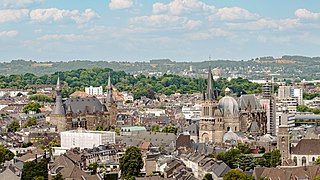
Aachen is the 13th-largest city in North Rhine-Westphalia and the 27th-largest city of Germany, with around 252,000 inhabitants.
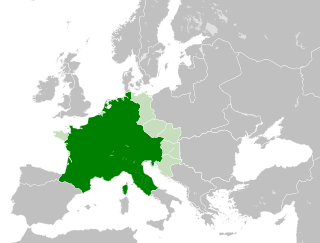
The Carolingian Empire (800–887) was a Frankish-dominated empire in western and central Europe during the Early Middle Ages. It was ruled by the Carolingian dynasty, which had ruled as kings of the Franks since 751 and as kings of the Lombards in Italy from 774. In 800, the Frankish king Charlemagne was crowned emperor in Rome by Pope Leo III in an effort to transfer the Roman Empire from the Byzantine Empire to Western Europe. The Carolingian Empire is sometimes considered the first phase in the history of the Holy Roman Empire.

The Carolingian Renaissance was the first of three medieval renaissances, a period of cultural activity in the Carolingian Empire. Charlemagne's reign led to an intellectual revival beginning in the 8th century and continuing throughout the 9th century, taking inspiration from ancient Roman and Greek culture and the Christian Roman Empire of the fourth century. During this period, there was an increase of literature, writing, visual arts, architecture, music, jurisprudence, liturgical reforms, and scriptural studies. Carolingian schools were effective centers of education, and they served generations of scholars by producing editions and copies of the classics, both Christian and pagan.

Aachen Cathedral is a Catholic church in Aachen, Germany and the seat of the Diocese of Aachen.
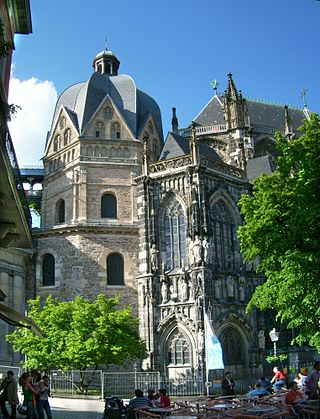
The Palatine Chapel in Aachen is an early medieval chapel and remaining component of Charlemagne's Palace of Aachen in what is now Germany. Although the palace itself no longer exists, the chapel was preserved and now forms the central part of Aachen Cathedral. It is Aachen's major landmark and a central monument of the Carolingian Renaissance. The chapel held the remains of Charlemagne. Later it was appropriated by the Ottonians and coronations were held there from 936 to 1531.
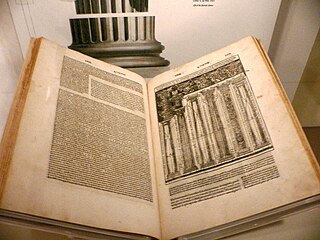
De architectura is a treatise on architecture written by the Roman architect and military engineer Marcus Vitruvius Pollio and dedicated to his patron, the emperor Caesar Augustus, as a guide for building projects. As the only treatise on architecture to survive from antiquity, it has been regarded since the Renaissance as the first known book on architectural theory, as well as a major source on the canon of classical architecture.

Pre-Romanesque art and architecture is the period in European art from either the emergence of the Merovingian kingdom in about 500 AD or from the Carolingian Renaissance in the late 8th century, to the beginning of the 11th century Romanesque period. The term is generally used in English only for architecture and monumental sculpture, but here all the arts of the period are briefly described.

Carolingian art comes from the Frankish Empire in the period of roughly 120 years from about 780 to 900—during the reign of Charlemagne and his immediate heirs—popularly known as the Carolingian Renaissance. The art was produced by and for the court circle and a group of important monasteries under Imperial patronage; survivals from outside this charmed circle show a considerable drop in quality of workmanship and sophistication of design. The art was produced in several centres in what are now France, Germany, Austria, northern Italy and the Low Countries, and received considerable influence, via continental mission centres, from the Insular art of the British Isles, as well as a number of Byzantine artists who appear to have been resident in Carolingian centres.

Germigny-des-Prés is a commune in the Loiret department in north-central France.

Carolingian architecture is the style of north European Pre-Romanesque architecture belonging to the period of the Carolingian Renaissance of the late 8th and 9th centuries, when the Carolingian dynasty dominated west European politics. It was a conscious attempt to emulate Roman architecture and to that end it borrowed heavily from Early Christian and Byzantine architecture, though there are nonetheless innovations of its own, resulting in a unique character.

Theodulf of Orléans was a writer, poet and the Bishop of Orléans during the reign of Charlemagne and Louis the Pious. He was a key member of the Carolingian Renaissance and an important figure during the many reforms of the church under Charlemagne, as well as almost certainly the author of the Libri Carolini, "much the fullest statement of the Western attitude to representational art that has been left to us by the Middle Ages". He is mainly remembered for this and the survival of the private oratory or chapel made for his villa at Germigny-des-Prés, with a mosaic probably from about 806. In Bible manuscripts produced under his influence, the Book of Baruch and the Letter of Jeremiah became part of the Western (Vulgate) Bible canon.
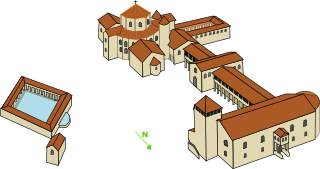
The Palace of Aachen was a group of buildings with residential, political, and religious purposes chosen by Charlemagne to be the center of power of the Carolingian Empire. The palace was located north of the current city of Aachen, today in the German Land of North Rhine-Westphalia. Most of the Carolingian palace was built in the 790s but the works went on until Charlemagne's death in 814. The plans, drawn by Odo of Metz, were part of the program of renovation of the kingdom decided by the ruler. Today much of the palace is ruined, but the Palatine Chapel has been preserved and is considered a masterpiece of Carolingian architecture and a characteristic example of architecture from the Carolingian Renaissance.
Michael of Synnada or Michael the Confessor was a metropolitan bishop of Synnada from 784/7 to 815. He represented Byzantium in diplomatic missions to Harun al-Rashid and Charlemagne. He was exiled by Emperor Leo V the Armenian because of his opposition to iconoclasm, and died on 23 May 826. He is honoured as a saint by the Eastern Orthodox and Roman Catholic churches, his feast day is May 23.

The Church of St. Donatus is a church located in Zadar, Croatia. Its name refers to Donatus of Zadar, who began construction on this church in the 9th century and ended it on the northeastern part of the Roman forum.

The Barbarossa Chandelier was made on the order of Emperor Frederick I, nicknamed Barbarossa, and his wife Beatrice sometime between 1165 and 1170 and was installed under the cupola of the Palatine Chapel in Aachen Cathedral. The chandelier was a donation in honour of Mary, Mother of God, the patroness of Aachen Cathedral and simultaneously represented a tribute to the builder of the cathedral, Charlemagne.

The Aachen penny of Charlemagne, a Carolingian silver coin, was found on 22 February 2008 in the foundations of the Palatine Chapel in Aachen, during archaeological work in the northeastern bay of the hexadecagon. This is the first discovery of coinage from the time of Charlemagne at Aachen.

Giovanni Carnevale was an Italian priest, writer and historian. His research revolves around the Carolingian age and Charlemagne.
















